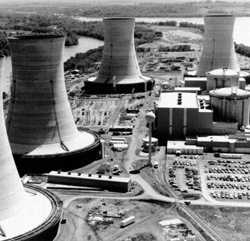Nuclear Accidents
The term meltdown refers to the melting of the fuel in the reactor. There have only been two cases of significant fuel melting: Three Mile Island in Pennsylvania and at Chernobyl in the Ukraine. Only in the case of Chernobyl were there significant offsite radiation releases.
Three Mile Island: On March 28, 1979, a minor malfunction led to a series of errors at the Three Mile Island nuclear power station just outside Harrisburg, Pennsylvania. The malfunction shut down the main and emergency cooling systems for a while.
Chernobyl: On April 26, 1986, an unwise engineering experiment at low power got out of control at the Chernobyl power reactor near Kiev, the capital of the Ukraine. The power level surged, the reactor vessel burst, hot steam exploded, and generated hydrogen mixed with oxygen of the atmosphere to produce an intense fire.


The residual heat of the nuclear wastes melted part of the core. The billion-dollar reactor was a total loss, but the worst damage was probably to the public’s trust in the safety of nuclear power. Still, the reactor vessel was not breached and the second line of defense—the heavy concrete “containment building”—also remained intact.
This was a big reactor and it was not encased in a containment building. The plume of the intense fire rose to high altitudes and spread radioactive debris over a wide area. Towns and villages near Chernobyl had to be evacuated and agricultural produce over much of Europe was contaminated. The remains of the reactor were later encased in a thick cover of concrete to entomb the radioactive waste left inside. In the last 24 years, the natural ecosystem has returned to the area and thrives more actively than it had for over a century prior to the meltdown. This is because people were evacuated from the area and no longer disturb the plants and animals. If the people return, they may again be a threat to the ecosystem.
